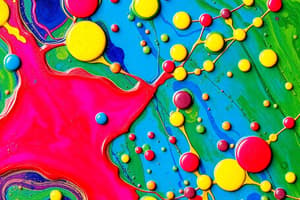Podcast
Questions and Answers
Which nanoparticle is primarily used for UV protection in paints?
Which nanoparticle is primarily used for UV protection in paints?
- Titanium dioxide (TiO2) (correct)
- Zinc oxide (ZnO)
- Carbon nanotubes
- Silicon dioxide (SiO2)
What is a key benefit of using nano-particles in Dulux's nanotechnology-based paint?
What is a key benefit of using nano-particles in Dulux's nanotechnology-based paint?
- Enhanced color strength and stability (correct)
- Lower VOC emissions
- Improved electrical conductivity
- Increased corrosion resistance
Which challenge of nanotechnology in paints pertains to economic feasibility?
Which challenge of nanotechnology in paints pertains to economic feasibility?
- Integration with emerging technologies
- Scalability and cost-effectiveness (correct)
- Standardization issues
- Toxicity concerns
Which company is NOT mentioned as investing in nanotechnology-based paints?
Which company is NOT mentioned as investing in nanotechnology-based paints?
What application area is NOT listed for nanotechnology-based paints?
What application area is NOT listed for nanotechnology-based paints?
What is the primary size range for nanoparticles used in the paint industry?
What is the primary size range for nanoparticles used in the paint industry?
What unique property do nanoparticles provide that conventional paints cannot?
What unique property do nanoparticles provide that conventional paints cannot?
What is a key feature of silver that makes it useful in antimicrobial coatings?
What is a key feature of silver that makes it useful in antimicrobial coatings?
Which of the following processes is employed to ensure that silver nanoparticles are eco-friendly?
Which of the following processes is employed to ensure that silver nanoparticles are eco-friendly?
Why are antimicrobial coatings particularly significant in hospitals?
Why are antimicrobial coatings particularly significant in hospitals?
The new method of synthesizing silver nanopowder aims to reduce what?
The new method of synthesizing silver nanopowder aims to reduce what?
What potential application for nanosilver powder is mentioned beyond its use in paints?
What potential application for nanosilver powder is mentioned beyond its use in paints?
Why is corrosion a significant issue in the industrial world?
Why is corrosion a significant issue in the industrial world?
What percentage of the global GDP in 2020 was the estimated annual cost of fighting corrosion?
What percentage of the global GDP in 2020 was the estimated annual cost of fighting corrosion?
What material is graphene primarily made from?
What material is graphene primarily made from?
What improvement did the addition of graphene provide in corrosion resistance during testing?
What improvement did the addition of graphene provide in corrosion resistance during testing?
What is a key benefit of TiO2-based nanocoatings according to businesses testing them?
What is a key benefit of TiO2-based nanocoatings according to businesses testing them?
Which company conducted research on graphene's anticorrosive properties?
Which company conducted research on graphene's anticorrosive properties?
What material was used as the substrate for testing the graphene coating?
What material was used as the substrate for testing the graphene coating?
What was the primary expectation of the nanoparticle delivery system developed by Swift Coat?
What was the primary expectation of the nanoparticle delivery system developed by Swift Coat?
What percentage is the estimated cost of fighting corrosion in relation to global GDP?
What percentage is the estimated cost of fighting corrosion in relation to global GDP?
What is the maximum potential reduction in solar panel efficiency due to soiling over time?
What is the maximum potential reduction in solar panel efficiency due to soiling over time?
What unique method is used to apply titanium dioxide-based nanoparticles to solar panels?
What unique method is used to apply titanium dioxide-based nanoparticles to solar panels?
What is one of the benefits of the titanium dioxide coating on solar panels?
What is one of the benefits of the titanium dioxide coating on solar panels?
What role do titanium dioxide nanoparticles play in the cleaning of solar panels?
What role do titanium dioxide nanoparticles play in the cleaning of solar panels?
What property of nanomaterials can enhance paints and coatings?
What property of nanomaterials can enhance paints and coatings?
What aspect does the process of applying the titanium dioxide coating allow for control over?
What aspect does the process of applying the titanium dioxide coating allow for control over?
Which benefit is NOT typically associated with the use of nanomaterials in paints?
Which benefit is NOT typically associated with the use of nanomaterials in paints?
What potential additional effect could the titanium dioxide coating have besides improving solar panel efficiency?
What potential additional effect could the titanium dioxide coating have besides improving solar panel efficiency?
Flashcards are hidden until you start studying
Study Notes
Antimicrobial Paints
- Silver nanoparticles mixed with paint can provide an antimicrobial coating solution.
- These nanoparticles can inhibit crucial cellular functions in microbes and kill bacteria and fungi.
- An eco-friendly process for synthesizing silver nanopowder uses a silica substrate with gum arabic, a biopolymer derived from the acacia tree.
Corrosion Resistance
- Global cost of fighting corrosion is estimated at $2.5 trillion annually.
- Nanoparticles can create highly effective alternatives to traditional industrial paints and coatings for corrosion resistance.
- Graphene, a super-thin material made from carbon atoms, exhibits promising anticorrosive properties.
- Graphene-based coatings showed a 62% improvement in scribe creep compared to control coatings, indicating significantly improved corrosion resistance.
Dust-Repellent Coatings
- TiO2-based nanocoatings can effectively control dust and dirt when exposed to UV radiation.
- These coatings improve the efficiency of solar panels by preventing dust and debris accumulation.
- Swift Coat developed a nanoparticle delivery system to create dust-repellent coatings for solar panels.
- The AIDA (aerosol impact-driven assembly) nanomaterial deposition method involves accelerating aerosolized nanoparticles at sonic speed through a nozzle to attach them to a substrate.
- This method allows for control over coating porosity and thickness, reducing reflectivity and improving solar panel efficiency.
Benefits of Nanomaterials in Paints
- Nanomaterials provide unique properties for paints, including antimicrobial, anticorrosive, and dust-repellent capabilities.
- These benefits offer advantages across various industries, including automotive, aerospace, construction, and marine applications.
- Benefits outweigh the costs, leading to longer-lasting and more efficient end products.
Studying That Suits You
Use AI to generate personalized quizzes and flashcards to suit your learning preferences.



